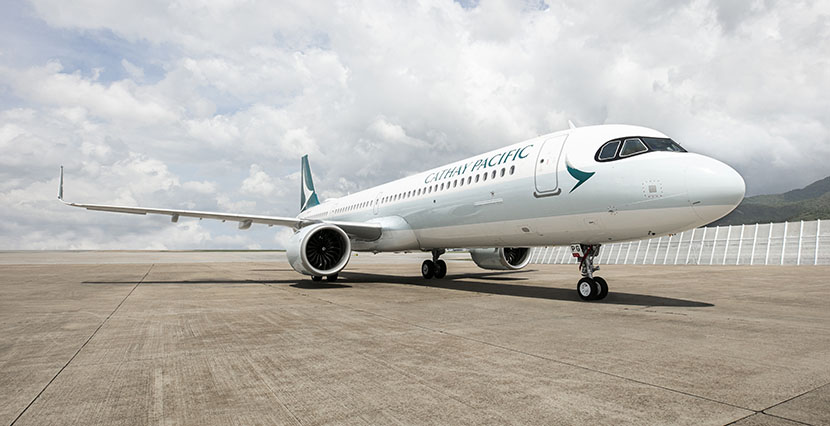Thursday, August 7, 2025
Author: Tuhin Sarkar

The longest flight by Cathay Pacific from Los Angeles to Hong Kong carrying nearly three hundred passengers has now made headlines for all the wrong reasons. What was supposed to be a routine transpacific journey turned into the longest flight ordeal in recent memory. This Cathay Pacific flight, flying from Los Angeles to Hong Kong, was forced to divert to Taiwan due to a sudden catastrophic storm. The flight carried nearly three hundred passengers who faced unexpected challenges high above Asia.
As the Cathay Pacific aircraft approached Hong Kong, a sudden and catastrophic storm struck the region. Torrential rainfall and dangerous conditions forced the longest flight by Cathay Pacific from Los Angeles to Hong Kong to abandon its landing. The flight, with nearly three hundred passengers onboard, diverted quickly to Taiwan for safety.
But once the Cathay Pacific plane landed in Taiwan, the nightmare didn’t end. Immigration and airspace laws prevented nearly three hundred passengers from disembarking. As a result, what started as a scheduled journey from Los Angeles to Hong Kong became the longest flight experience for those on board, not by miles but by time and exhaustion. The sudden catastrophic storm that led to the Taiwan diversion turned a 13-hour flight into a 29-hour ordeal.
This introduction gives a clear update on how the longest flight from Los Angeles to Hong Kong by Cathay Pacific, carrying nearly three hundred passengers, turned into a global travel story due to an unexpected, catastrophic storm and a diversion to Taiwan.
Passengers aboard Cathay Pacific flight CX883 experienced what could be one of the longest flight disruptions in history. The journey, from Los Angeles to Hong Kong, turned into a 29-hour ordeal after a violent ‘black storm’ hit Hong Kong during landing. The plane was forced to divert to Taiwan, where passengers were stuck onboard for 11 hours. The event has sparked global debate on flight regulations, weather preparedness, and passenger rights.
A Routine Flight Turns Into Record-Breaking Chaos
Flight CX883 took off from Los Angeles International Airport at 12:55 am on 4 August 2025. The aircraft, a 15-year-old Boeing 777, carried nearly 300 passengers expecting a 13-hour transpacific flight to Hong Kong. But what was supposed to be a smooth ride turned into chaos when severe weather hit Hong Kong.
As the plane approached Hong Kong International Airport, it descended to just 5,000 feet before the pilots aborted landing. The city was being hit by a ‘black rainstorm’—Hong Kong’s most extreme weather warning. Over 13.8 inches of rain fell in just a few hours, the highest August rainfall since 1884.
With visibility near zero and flooding reported across the city, the crew had no choice but to divert.
Taiwan Diversion Adds to the Turmoil
The aircraft was rerouted to Taoyuan International Airport in Taiwan. Passengers expected to disembark and wait safely in the terminal. But they were told they had to remain on board. Due to second freedom of the air laws and immigration restrictions, Cathay Pacific was not allowed to let passengers off the plane.
This left nearly 300 people trapped in their seats. The plane remained parked on a remote stand. There was no fresh air, no access to proper meals, and no way to stretch. Tensions quickly rose inside the cabin.
Cabin Conditions Push Crew and Passengers to Their Limits
As hours passed, passengers became distressed. Food supplies were running low. Tempers flared. Some began demanding to be let off the plane. Others complained of headaches and discomfort from sitting so long. The air inside the cabin felt hot and stale.
A video posted on Threads by aviation engineer @mfahadnaimb, who was onboard, showed real-time footage of the storm outside and the passengers’ emotional reactions. While the initial turbulence brought some laughter, the mood soon turned tense.
The crew also struggled. They had been working for nearly a full day. According to reports, Cathay Pacific had to swap out the flight crew during the layover. New pilots and flight attendants were brought in to complete the journey safely and legally.
A Frustrated Wait Followed by a Late Landing
After a total of 11 hours stuck on the tarmac in Taiwan, the aircraft finally took off again. It landed in Hong Kong at 7:15 pm on 5 August. The entire journey took 28 hours and 20 minutes, from gate to gate.
Passengers disembarked feeling exhausted, angry, and frustrated. Many had missed connections, hotel bookings, and important events. Some even posted on social media saying they would never fly with Cathay Pacific again.
What Is a ‘Black Rainstorm Warning’?
A black rainstorm warning is the most severe weather alert in Hong Kong. It means rainfall exceeds 70mm (2.8 inches) per hour and is expected to continue. Schools and offices are advised to close, public transport may shut down, and flooding is likely.
This rare warning was issued during the CX883 flight’s final approach. It marked the highest rainfall in August since records began in 1884. Under such conditions, no airport in the world would allow a landing.
Cathay Pacific made the right decision by diverting the plane, but the lack of a passenger release plan in Taiwan has raised serious concerns.
The Legal Grey Area That Trapped 300 People
The situation on CX883 was worsened by aviation law. Second freedom rights allow technical stops for refuelling or safety but do not allow passengers to get off if immigration rules are not cleared in advance.
Cathay Pacific likely did not want to process hundreds of international travellers through Taiwanese customs. This would require new visas, hotel rooms, and special arrangements for onward travel. The airline may also have faced insurance and liability risks.
Still, keeping passengers confined for 11 hours sparked a public backlash. Experts say airlines need clearer plans for such diversions—especially in the face of worsening climate events.
Could This Be the Longest Flight Delay Ever?
This flight did not break the record for distance. However, it may be one of the longest delays experienced entirely onboard a plane. Other long diversions have occurred in the past, but most involved passengers being taken off the plane for rest or food.
What made CX883 unique was the length of time spent on the tarmac without letting anyone out. It highlighted how international flight rules, weather events, and poor planning can collide in modern aviation.
What Travellers Should Learn from This Incident
The story of Cathay Pacific Flight CX883 is a warning for travellers. Weather events are becoming more intense and unpredictable. Airlines must plan better for emergencies, especially when it comes to passenger comfort and legal limits.
Travellers should also be prepared:
- Carry snacks, water, and medicine in your hand luggage
- Bring a phone charger and backup battery
- Have contact details for your hotel and travel insurance ready
- Download your airline’s app for real-time updates
Being ready for delays is part of flying now. But airlines must also do their part.
Cathay Pacific Yet to Issue Full Response
As of 7 August 2025, Cathay Pacific has not released an official statement about the incident. Passengers and aviation watchers are calling for transparency. Many want to know why a plan wasn’t in place for such weather, and why passengers had to suffer such extreme discomfort.
The airline is facing criticism, not just for the delay, but for its communication. Some passengers say they were left in the dark for hours, with no clear updates or apologies from the crew.
A Flight to Remember, for All the Wrong Reasons
Flight CX883 will go down in aviation history—not for its destination, but for the hardship its passengers endured. A black storm in Hong Kong caused the chaos. But it was the failure to let passengers off the plane in Taiwan that turned a delay into a disaster.
Cathay Pacific now joins a growing list of airlines facing pressure to improve crisis response. As climate events grow more severe, this story shows how airlines must adapt. Fast decisions, better passenger care, and strong legal planning will be key to avoiding the next 29-hour nightmare.







